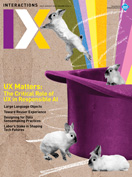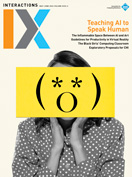Table of Contents
VOLUME XV.1 January + February 2008
-
WELCOME
-
Interactions: experiences, people, technology
Richard Anderson, Jon Kolko
Our world is at the point of major change, fueled by the increasing capabilities of technology, the imminent entry of enormous powerhouse countries into the global economy, and the potential for catastrophic environmental and cultural flux on both a local and global level. The opportunities are tremendous, yet the…
-
-
On the language of Interactions
-
Ps AND QsWhat’s in a name?
Elizabeth Churchill
"I'll wall you," someone teased me the other day. If you do, I'll poke you, I retorted. We both laughed. The person sitting next to us looked mystified. I proceeded to try and explain that no, my friend wasn't going to come to my house with a spray-paint can…
-
FEATUREPrimal interactions
Alex Wright
As emerging Web technologies fuel the rise of so-called social media (think YouTube, Facebook, and Twitter), the practice of interaction design is evolving from its roots in human-computer interfaces to address a broader range of human-to-human activities. Designers who once trafficked in task analysis and usability heuristics now frequently…
-
(P)REVIEWGlut
Fred Sampson
By Alex Wright Joseph Henry Press, 2007 ISBN 978-0-309-10238-4 $27.95 Reviewed by Fred Sampson Alex Wright, information architect at The New York Times, presents in Glut a history of information over thousands of yearsindeed, from the beginnings of life on earth. Wright's insights and analysis provide a lucid perspective…
-
FEATURERealizing the vision of mobile spatial interaction
Peter Froehlich, Lynne Baillie, Rainer Simon
Mobile computers are increasingly used as a link between the physical and the digital worlds. This innovation demands a more sophisticated multidisciplinary approach to the modeling of spatial interaction than has yet been developed. Our aim in this article is to open up the "black box" of mobile spatial…
-
FEATUREThe linguistic command line
Aza Raskin
I'm a Mac baby. Twenty-three years ago, I was born. So was the Macintosh. Looking back, I haven't fundamentally changed since my lower-than-your-kneecap days. I'm just a larger, differently proportioned version of my younger self. Unfortunately, the same thing is also true for the GUI: It's matured, but hasn't…
-
FEATUREUnderstanding convergence
Stefana Broadbent, Valérie Bauwens
Convergence has been the mantra of the information and communication-technology industries for the past few years, and it is defining the strategy of every Telco, broadcaster, ISP, and phone manufacturer in the world. Technically, convergence defines a multimedia environment and/or network where signals, regardless of type (i.e., voice, quality…
-
-
Key process, management & organizational interactions
-
COVER STORYToward a model of innovation
Hugh Dubberly
For the past few years, innovation has been a big topic in conversation about business management. A small industry fuels that conversation with articles, books, and conferences. Designers, too, are involved. Prominent product-design firms offer workshops and other services promising innovation. Leading design schools promote "design thinking" as a…
-
FEATUREThe business of customer experience
Secil Watson
Of the many executives I've come to know who oversee corporate-experience research and design personnel and activities, Secil Watson of Wells Fargo is one of the most insightful and inspirational. Members of her staff agree, praising "her leadership and visionshe has the brain of a businesswoman, heart of a…
-
(P)REVIEWDesign education for business and engineering management students
Terry Winograd
Don Norman is the "Don" of interaction design, having written several of the most influential books and spoken, consulted, and led design research at companies such as Apple and HP. The progression of his interests and insights over the years has led the path of HCI and interaction design.…
-
FEATUREDesigning for disagreement
Paul Burke
Creativity is a leap of faith into unknown territory, and the key attribute of a creative problem solver is the ability to make the appropriate leaps. It is through a methodologywhether implicit or explicitthat a creative mind can navigate a problem space, know when to make a leap, and…
-
THAT’S ENTERTAINMNTHalo 3
Dennis Wixon, Randy Pagulayan
In the September-October issue of interactions, creative director for the Windows Core Innovation Team, August de los Reyes, and I described an approach to designing emotionally engaging products. The approach is based on the James-Lange theorya pioneering theory of emotion that places physical activity as the source of emotions,…
-
-
Addressing critical challenges
-
FEATUREDesigning for the last billion
Gabriel White
In the developing world, access to mobile phones can have a significant positive impact on people's lives. Phones can increase the sale price of produce by providing farmers with better access to information and markets; they can give tradesmen the ability to serve customers beyond their immediate area. In…
-
UNDER DEVELOPMENTNew users, new paradigms, new challenges
Gary Marsden
It is not surprising that the field of HCI has been closely bound to Moore's law. At its inception, HCI was concerned primarily with the only large group of people who had access to the technologyoffice workers. This type of user had very clearly defined tasks and goals that…
-
SUSTAINABLY OURSTwo digital divides and four perspectives
Eli Blevis
The issue of sustainability and its relation to global warming pervades present-day popular press in a manner that could not have been conceived just a few years ago. There is clear consensus among the scientific community that carbon-dioxide-producing human behaviors are closely linked to and a primary cause of…
-
LIFELONG INTERACTIONSMy father’s kitchen table
Allison Druin
One late night, I sat at my father's kitchen table swapping "work stories." I told him about my never-ending lab meetings and emails, and he told me about his frequent fights with his computer. At 65, my father is an active consultant to the plastics industry, with a Ph.D.…
-
-
Unanticipated consequences & influences
-
THE WAY I SEE ITFilling much-needed holes
Donald Norman
Summary: Many of our clever ethnographic and field methods are designed to identify unmet needs. You know what? Most are far better off if they stay unmet. One of my mentors, the distinguished American psychologist George Miller, once passed judgment on the contributions of a research scientist by stating,…
-
TRUE TALESPersona non grata
Steve Portigal
One recent morning I came into my office and found a small woman astride my desk. Well, to be precise, it wasn't an actual woman. It was a cutout of a photograph of a doll representing an archetypal customera persona. My officemate had brought this odd item back for…
-
TIME LINESUnanticipated and contingent influences on the evolution of the internet
Glenn Kowack
Glenn Kowack, a pioneering networking entrepreneur, is writing a book about forces underlying unforeseen consequences in uses of digital technologies. This excerpt provides a fascinating perspective on the evolution of the Internet. Glenn and I have been good friends since w e met in late 1978 in the Tampa…
-
-
Interactions Cafe
-
On innovation, appropriateness, intervention design…
Richard Anderson, Jon Kolko
Shortly after attending the ICSID-IDSA CONNECTING '07 World Design Congress in San Francisco, EICs Jon and Richard sat down to discuss the conference and its relationship to this issue of interactions. Jon: I'm concerned with the overabundance of the word "innovation" in our professional discipline. At CONNECTING '07, the…
-



